Leadership Management
VerifiedAdded on 2023/06/11
|12
|2719
|273
AI Summary
This article provides a literature review on leadership coaching and mixed research design. It discusses the appropriateness and characteristics of mixed research design, implications for theory and leaders, and a critical analysis of the outcomes presented in the research.
Contribute Materials
Your contribution can guide someone’s learning journey. Share your
documents today.
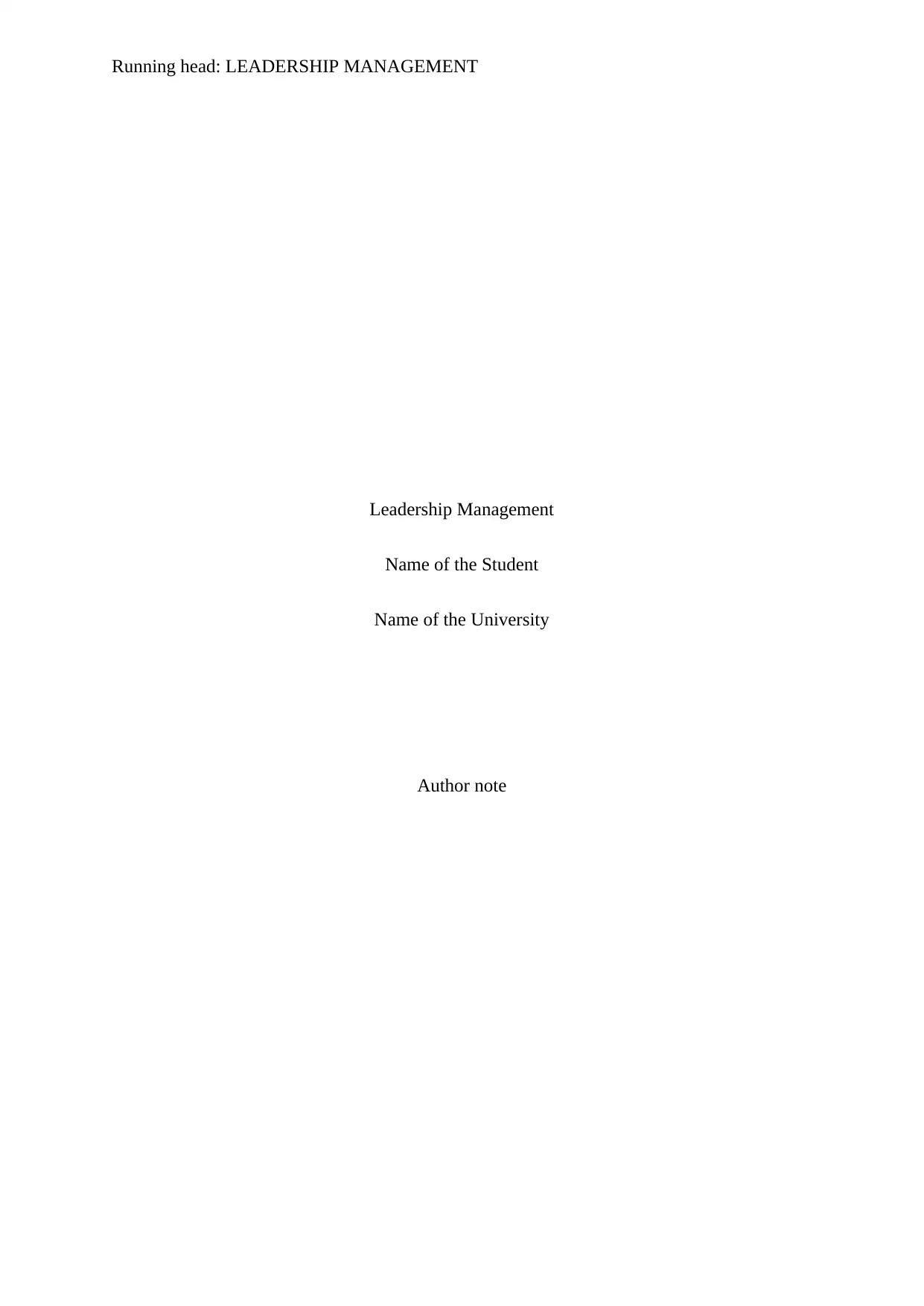
Running head: LEADERSHIP MANAGEMENT
Leadership Management
Name of the Student
Name of the University
Author note
Leadership Management
Name of the Student
Name of the University
Author note
Secure Best Marks with AI Grader
Need help grading? Try our AI Grader for instant feedback on your assignments.
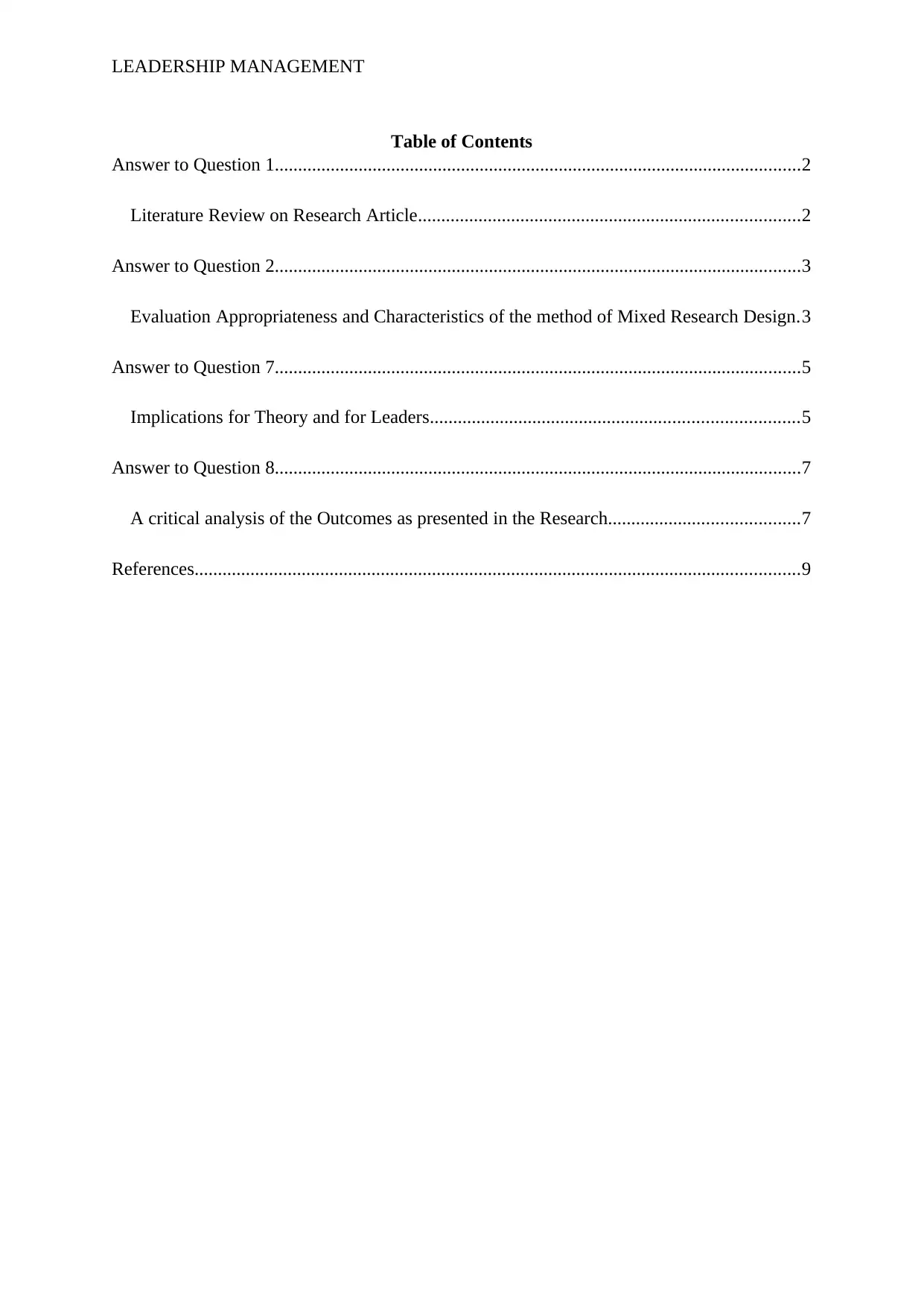
LEADERSHIP MANAGEMENT
Table of Contents
Answer to Question 1.................................................................................................................2
Literature Review on Research Article..................................................................................2
Answer to Question 2.................................................................................................................3
Evaluation Appropriateness and Characteristics of the method of Mixed Research Design.3
Answer to Question 7.................................................................................................................5
Implications for Theory and for Leaders...............................................................................5
Answer to Question 8.................................................................................................................7
A critical analysis of the Outcomes as presented in the Research.........................................7
References..................................................................................................................................9
Table of Contents
Answer to Question 1.................................................................................................................2
Literature Review on Research Article..................................................................................2
Answer to Question 2.................................................................................................................3
Evaluation Appropriateness and Characteristics of the method of Mixed Research Design.3
Answer to Question 7.................................................................................................................5
Implications for Theory and for Leaders...............................................................................5
Answer to Question 8.................................................................................................................7
A critical analysis of the Outcomes as presented in the Research.........................................7
References..................................................................................................................................9
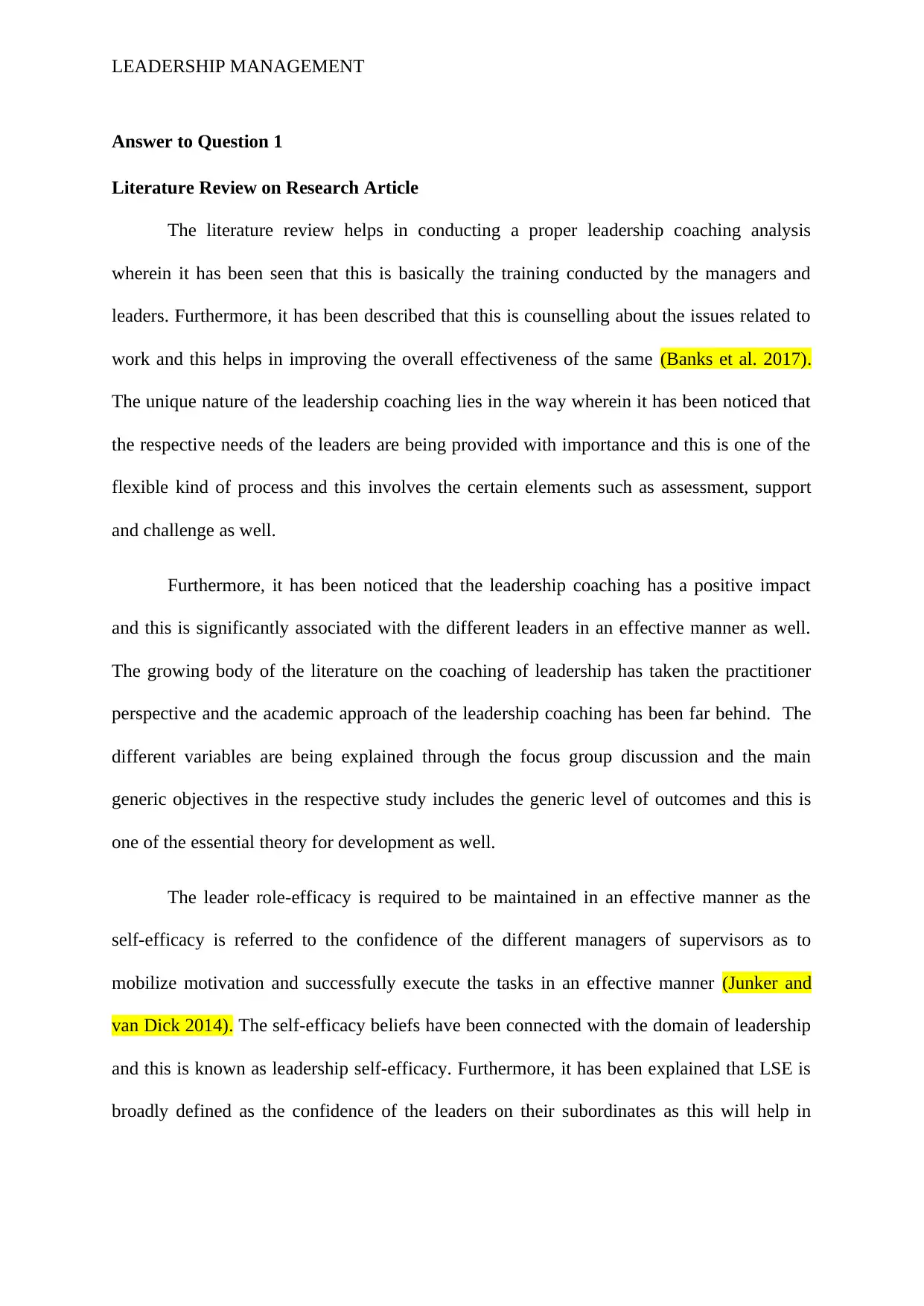
LEADERSHIP MANAGEMENT
Answer to Question 1
Literature Review on Research Article
The literature review helps in conducting a proper leadership coaching analysis
wherein it has been seen that this is basically the training conducted by the managers and
leaders. Furthermore, it has been described that this is counselling about the issues related to
work and this helps in improving the overall effectiveness of the same (Banks et al. 2017).
The unique nature of the leadership coaching lies in the way wherein it has been noticed that
the respective needs of the leaders are being provided with importance and this is one of the
flexible kind of process and this involves the certain elements such as assessment, support
and challenge as well.
Furthermore, it has been noticed that the leadership coaching has a positive impact
and this is significantly associated with the different leaders in an effective manner as well.
The growing body of the literature on the coaching of leadership has taken the practitioner
perspective and the academic approach of the leadership coaching has been far behind. The
different variables are being explained through the focus group discussion and the main
generic objectives in the respective study includes the generic level of outcomes and this is
one of the essential theory for development as well.
The leader role-efficacy is required to be maintained in an effective manner as the
self-efficacy is referred to the confidence of the different managers of supervisors as to
mobilize motivation and successfully execute the tasks in an effective manner (Junker and
van Dick 2014). The self-efficacy beliefs have been connected with the domain of leadership
and this is known as leadership self-efficacy. Furthermore, it has been explained that LSE is
broadly defined as the confidence of the leaders on their subordinates as this will help in
Answer to Question 1
Literature Review on Research Article
The literature review helps in conducting a proper leadership coaching analysis
wherein it has been seen that this is basically the training conducted by the managers and
leaders. Furthermore, it has been described that this is counselling about the issues related to
work and this helps in improving the overall effectiveness of the same (Banks et al. 2017).
The unique nature of the leadership coaching lies in the way wherein it has been noticed that
the respective needs of the leaders are being provided with importance and this is one of the
flexible kind of process and this involves the certain elements such as assessment, support
and challenge as well.
Furthermore, it has been noticed that the leadership coaching has a positive impact
and this is significantly associated with the different leaders in an effective manner as well.
The growing body of the literature on the coaching of leadership has taken the practitioner
perspective and the academic approach of the leadership coaching has been far behind. The
different variables are being explained through the focus group discussion and the main
generic objectives in the respective study includes the generic level of outcomes and this is
one of the essential theory for development as well.
The leader role-efficacy is required to be maintained in an effective manner as the
self-efficacy is referred to the confidence of the different managers of supervisors as to
mobilize motivation and successfully execute the tasks in an effective manner (Junker and
van Dick 2014). The self-efficacy beliefs have been connected with the domain of leadership
and this is known as leadership self-efficacy. Furthermore, it has been explained that LSE is
broadly defined as the confidence of the leaders on their subordinates as this will help in
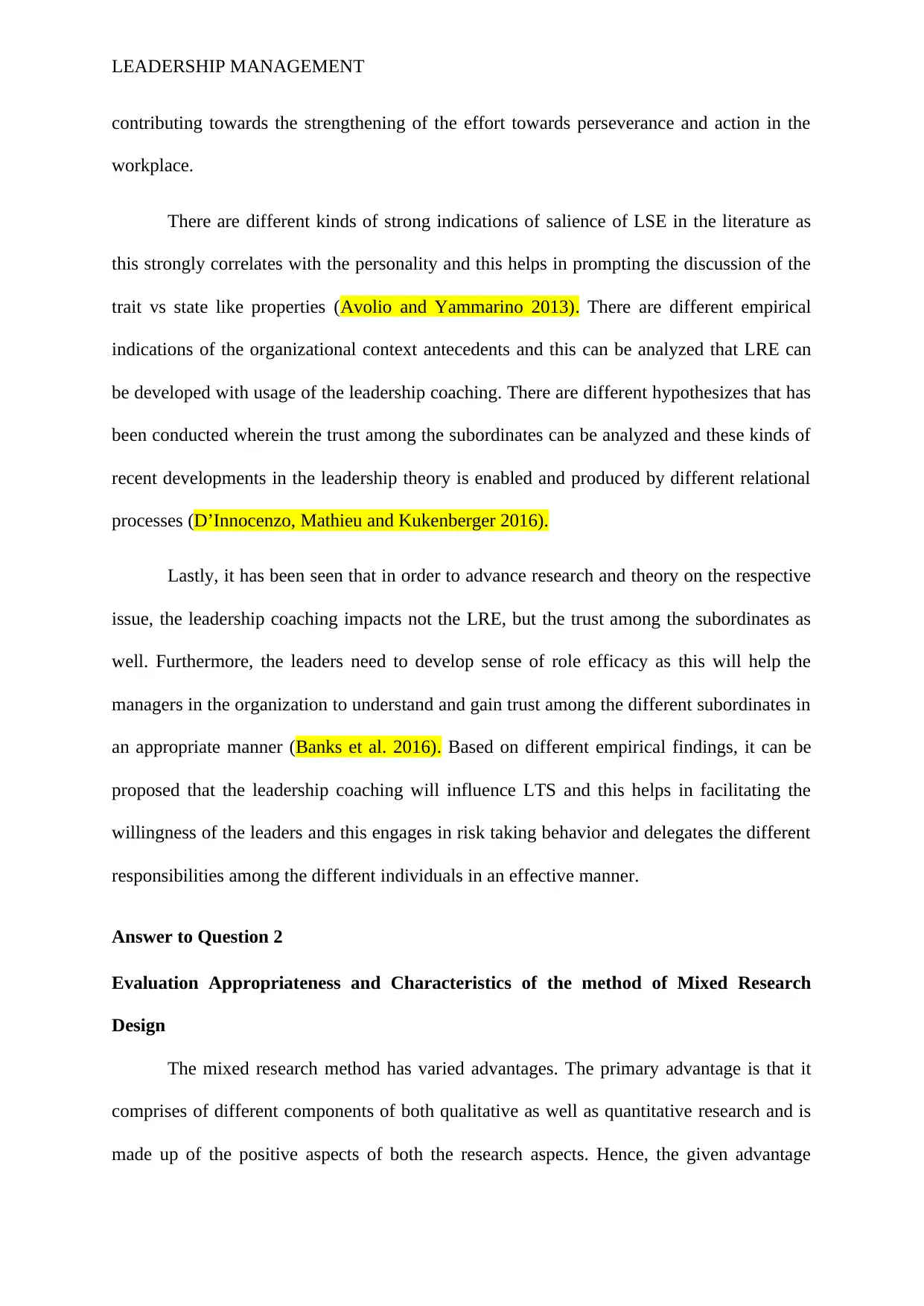
LEADERSHIP MANAGEMENT
contributing towards the strengthening of the effort towards perseverance and action in the
workplace.
There are different kinds of strong indications of salience of LSE in the literature as
this strongly correlates with the personality and this helps in prompting the discussion of the
trait vs state like properties (Avolio and Yammarino 2013). There are different empirical
indications of the organizational context antecedents and this can be analyzed that LRE can
be developed with usage of the leadership coaching. There are different hypothesizes that has
been conducted wherein the trust among the subordinates can be analyzed and these kinds of
recent developments in the leadership theory is enabled and produced by different relational
processes (D’Innocenzo, Mathieu and Kukenberger 2016).
Lastly, it has been seen that in order to advance research and theory on the respective
issue, the leadership coaching impacts not the LRE, but the trust among the subordinates as
well. Furthermore, the leaders need to develop sense of role efficacy as this will help the
managers in the organization to understand and gain trust among the different subordinates in
an appropriate manner (Banks et al. 2016). Based on different empirical findings, it can be
proposed that the leadership coaching will influence LTS and this helps in facilitating the
willingness of the leaders and this engages in risk taking behavior and delegates the different
responsibilities among the different individuals in an effective manner.
Answer to Question 2
Evaluation Appropriateness and Characteristics of the method of Mixed Research
Design
The mixed research method has varied advantages. The primary advantage is that it
comprises of different components of both qualitative as well as quantitative research and is
made up of the positive aspects of both the research aspects. Hence, the given advantage
contributing towards the strengthening of the effort towards perseverance and action in the
workplace.
There are different kinds of strong indications of salience of LSE in the literature as
this strongly correlates with the personality and this helps in prompting the discussion of the
trait vs state like properties (Avolio and Yammarino 2013). There are different empirical
indications of the organizational context antecedents and this can be analyzed that LRE can
be developed with usage of the leadership coaching. There are different hypothesizes that has
been conducted wherein the trust among the subordinates can be analyzed and these kinds of
recent developments in the leadership theory is enabled and produced by different relational
processes (D’Innocenzo, Mathieu and Kukenberger 2016).
Lastly, it has been seen that in order to advance research and theory on the respective
issue, the leadership coaching impacts not the LRE, but the trust among the subordinates as
well. Furthermore, the leaders need to develop sense of role efficacy as this will help the
managers in the organization to understand and gain trust among the different subordinates in
an appropriate manner (Banks et al. 2016). Based on different empirical findings, it can be
proposed that the leadership coaching will influence LTS and this helps in facilitating the
willingness of the leaders and this engages in risk taking behavior and delegates the different
responsibilities among the different individuals in an effective manner.
Answer to Question 2
Evaluation Appropriateness and Characteristics of the method of Mixed Research
Design
The mixed research method has varied advantages. The primary advantage is that it
comprises of different components of both qualitative as well as quantitative research and is
made up of the positive aspects of both the research aspects. Hence, the given advantage
Secure Best Marks with AI Grader
Need help grading? Try our AI Grader for instant feedback on your assignments.
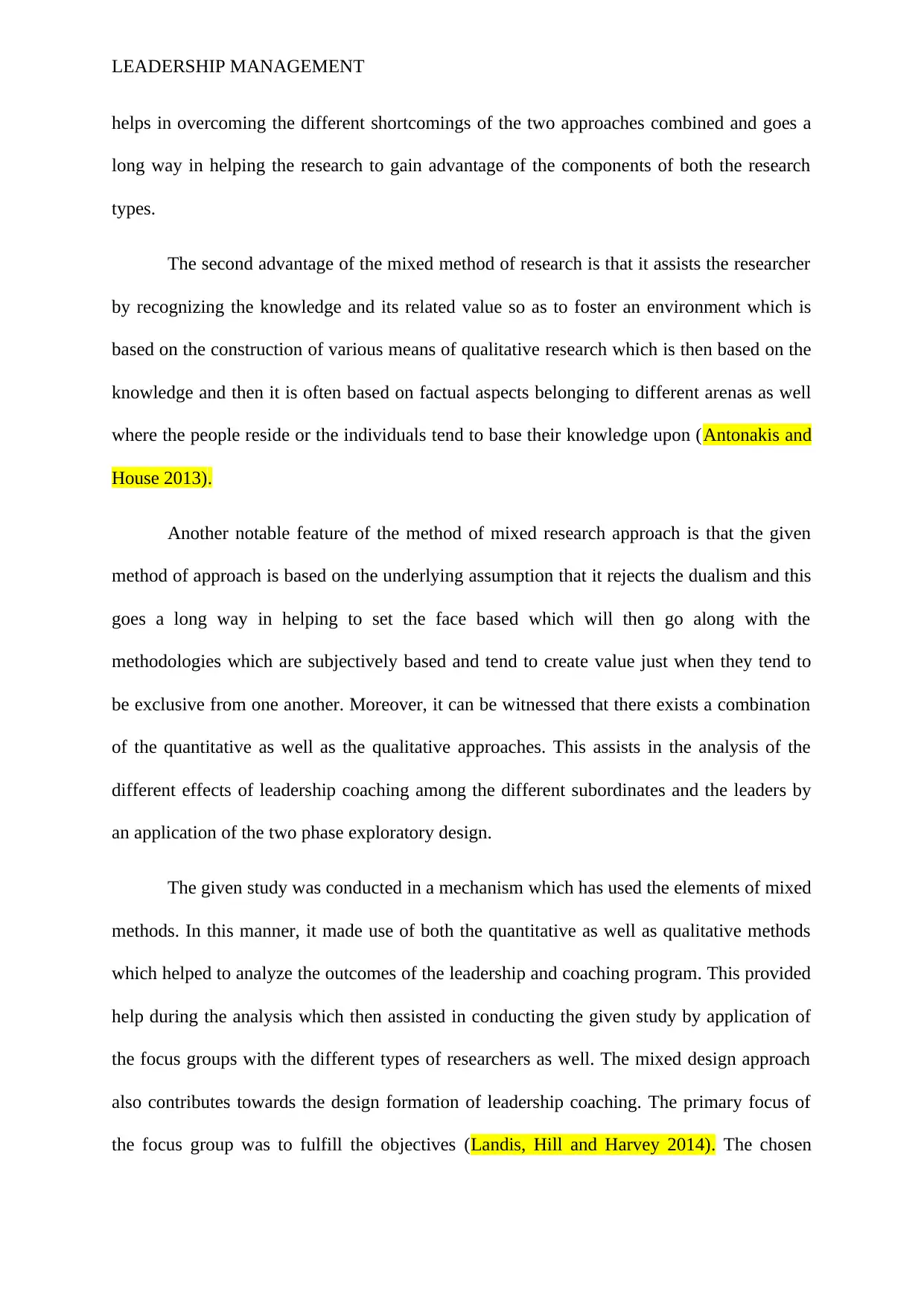
LEADERSHIP MANAGEMENT
helps in overcoming the different shortcomings of the two approaches combined and goes a
long way in helping the research to gain advantage of the components of both the research
types.
The second advantage of the mixed method of research is that it assists the researcher
by recognizing the knowledge and its related value so as to foster an environment which is
based on the construction of various means of qualitative research which is then based on the
knowledge and then it is often based on factual aspects belonging to different arenas as well
where the people reside or the individuals tend to base their knowledge upon (Antonakis and
House 2013).
Another notable feature of the method of mixed research approach is that the given
method of approach is based on the underlying assumption that it rejects the dualism and this
goes a long way in helping to set the face based which will then go along with the
methodologies which are subjectively based and tend to create value just when they tend to
be exclusive from one another. Moreover, it can be witnessed that there exists a combination
of the quantitative as well as the qualitative approaches. This assists in the analysis of the
different effects of leadership coaching among the different subordinates and the leaders by
an application of the two phase exploratory design.
The given study was conducted in a mechanism which has used the elements of mixed
methods. In this manner, it made use of both the quantitative as well as qualitative methods
which helped to analyze the outcomes of the leadership and coaching program. This provided
help during the analysis which then assisted in conducting the given study by application of
the focus groups with the different types of researchers as well. The mixed design approach
also contributes towards the design formation of leadership coaching. The primary focus of
the focus group was to fulfill the objectives (Landis, Hill and Harvey 2014). The chosen
helps in overcoming the different shortcomings of the two approaches combined and goes a
long way in helping the research to gain advantage of the components of both the research
types.
The second advantage of the mixed method of research is that it assists the researcher
by recognizing the knowledge and its related value so as to foster an environment which is
based on the construction of various means of qualitative research which is then based on the
knowledge and then it is often based on factual aspects belonging to different arenas as well
where the people reside or the individuals tend to base their knowledge upon (Antonakis and
House 2013).
Another notable feature of the method of mixed research approach is that the given
method of approach is based on the underlying assumption that it rejects the dualism and this
goes a long way in helping to set the face based which will then go along with the
methodologies which are subjectively based and tend to create value just when they tend to
be exclusive from one another. Moreover, it can be witnessed that there exists a combination
of the quantitative as well as the qualitative approaches. This assists in the analysis of the
different effects of leadership coaching among the different subordinates and the leaders by
an application of the two phase exploratory design.
The given study was conducted in a mechanism which has used the elements of mixed
methods. In this manner, it made use of both the quantitative as well as qualitative methods
which helped to analyze the outcomes of the leadership and coaching program. This provided
help during the analysis which then assisted in conducting the given study by application of
the focus groups with the different types of researchers as well. The mixed design approach
also contributes towards the design formation of leadership coaching. The primary focus of
the focus group was to fulfill the objectives (Landis, Hill and Harvey 2014). The chosen
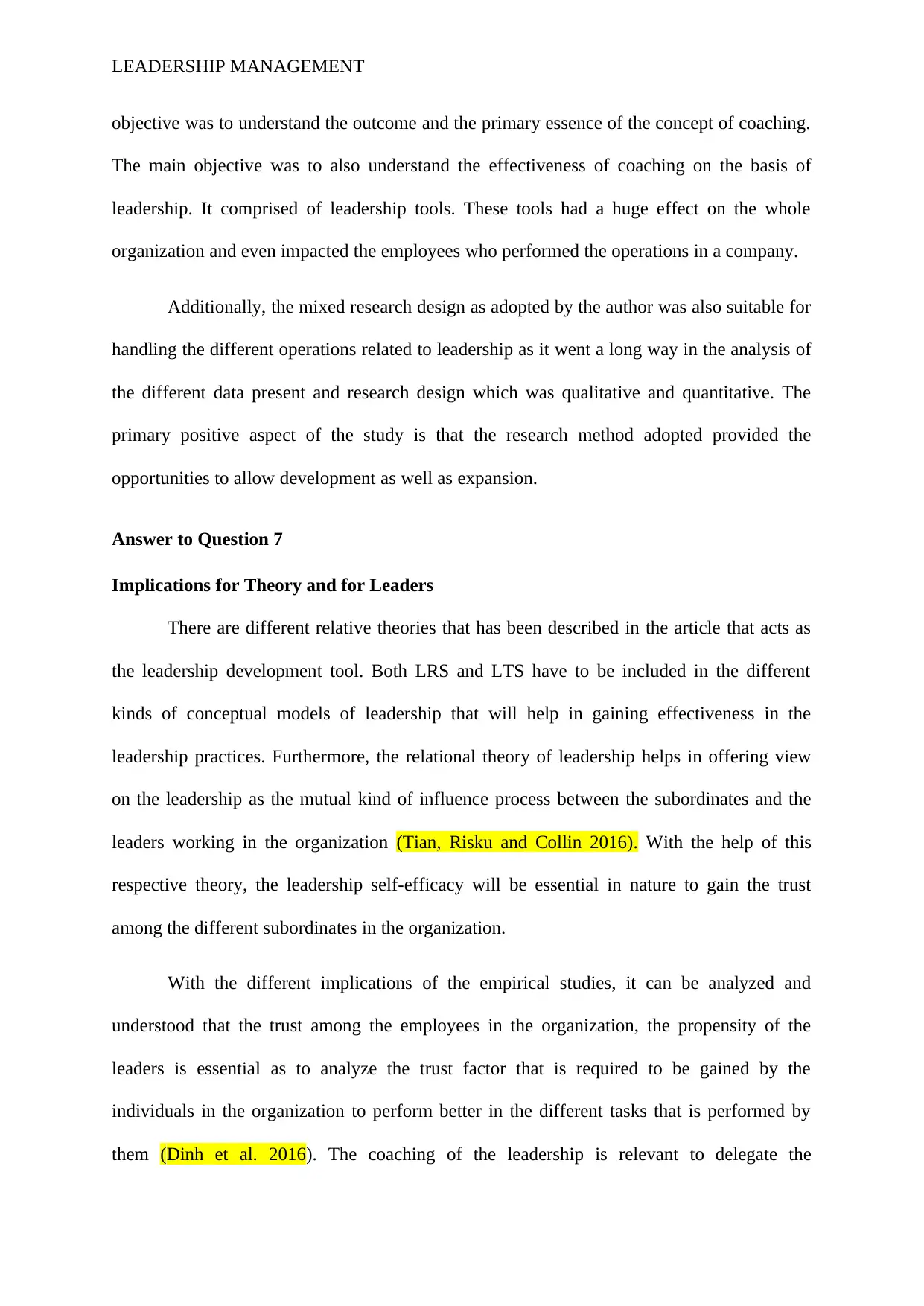
LEADERSHIP MANAGEMENT
objective was to understand the outcome and the primary essence of the concept of coaching.
The main objective was to also understand the effectiveness of coaching on the basis of
leadership. It comprised of leadership tools. These tools had a huge effect on the whole
organization and even impacted the employees who performed the operations in a company.
Additionally, the mixed research design as adopted by the author was also suitable for
handling the different operations related to leadership as it went a long way in the analysis of
the different data present and research design which was qualitative and quantitative. The
primary positive aspect of the study is that the research method adopted provided the
opportunities to allow development as well as expansion.
Answer to Question 7
Implications for Theory and for Leaders
There are different relative theories that has been described in the article that acts as
the leadership development tool. Both LRS and LTS have to be included in the different
kinds of conceptual models of leadership that will help in gaining effectiveness in the
leadership practices. Furthermore, the relational theory of leadership helps in offering view
on the leadership as the mutual kind of influence process between the subordinates and the
leaders working in the organization (Tian, Risku and Collin 2016). With the help of this
respective theory, the leadership self-efficacy will be essential in nature to gain the trust
among the different subordinates in the organization.
With the different implications of the empirical studies, it can be analyzed and
understood that the trust among the employees in the organization, the propensity of the
leaders is essential as to analyze the trust factor that is required to be gained by the
individuals in the organization to perform better in the different tasks that is performed by
them (Dinh et al. 2016). The coaching of the leadership is relevant to delegate the
objective was to understand the outcome and the primary essence of the concept of coaching.
The main objective was to also understand the effectiveness of coaching on the basis of
leadership. It comprised of leadership tools. These tools had a huge effect on the whole
organization and even impacted the employees who performed the operations in a company.
Additionally, the mixed research design as adopted by the author was also suitable for
handling the different operations related to leadership as it went a long way in the analysis of
the different data present and research design which was qualitative and quantitative. The
primary positive aspect of the study is that the research method adopted provided the
opportunities to allow development as well as expansion.
Answer to Question 7
Implications for Theory and for Leaders
There are different relative theories that has been described in the article that acts as
the leadership development tool. Both LRS and LTS have to be included in the different
kinds of conceptual models of leadership that will help in gaining effectiveness in the
leadership practices. Furthermore, the relational theory of leadership helps in offering view
on the leadership as the mutual kind of influence process between the subordinates and the
leaders working in the organization (Tian, Risku and Collin 2016). With the help of this
respective theory, the leadership self-efficacy will be essential in nature to gain the trust
among the different subordinates in the organization.
With the different implications of the empirical studies, it can be analyzed and
understood that the trust among the employees in the organization, the propensity of the
leaders is essential as to analyze the trust factor that is required to be gained by the
individuals in the organization to perform better in the different tasks that is performed by
them (Dinh et al. 2016). The coaching of the leadership is relevant to delegate the
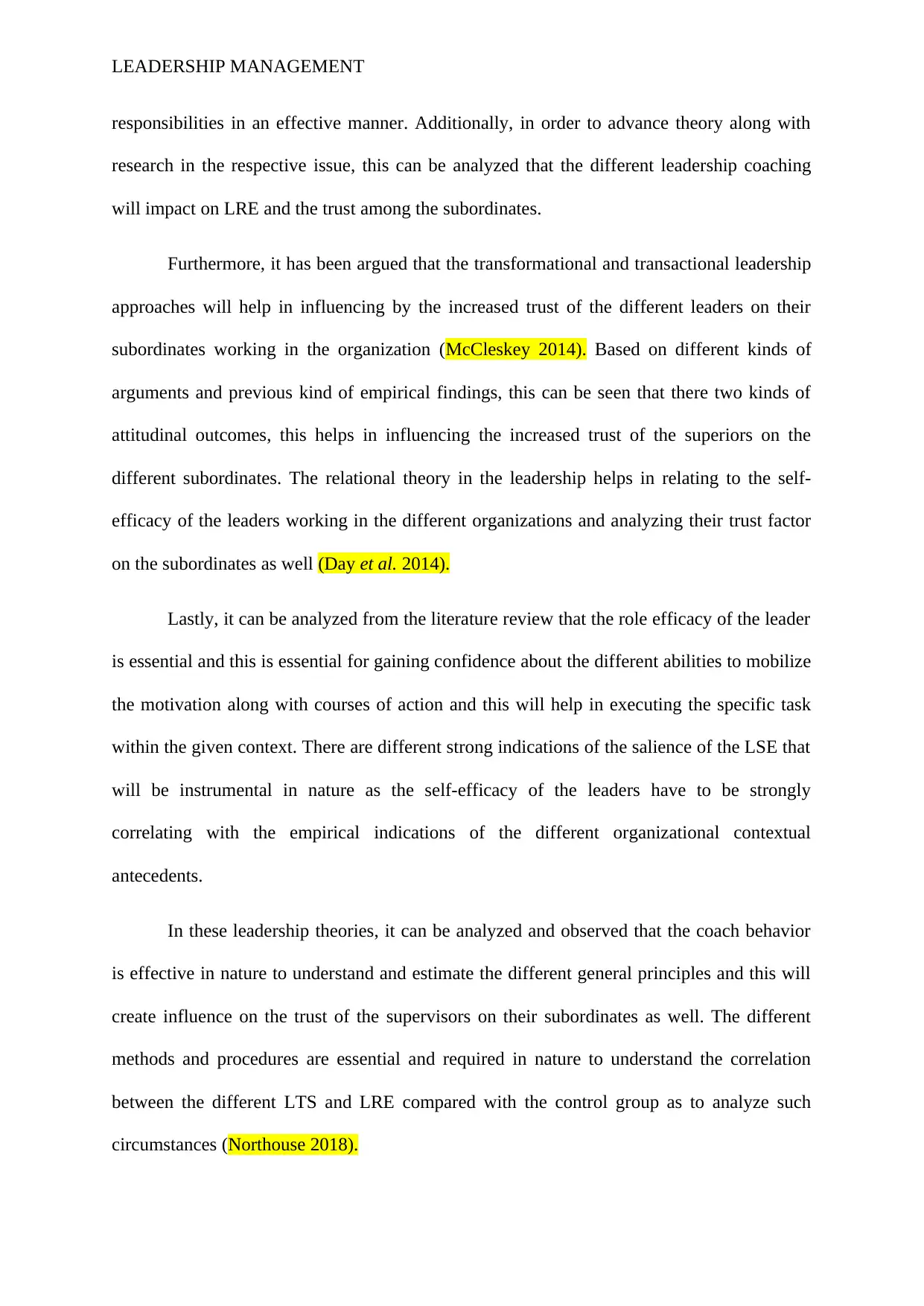
LEADERSHIP MANAGEMENT
responsibilities in an effective manner. Additionally, in order to advance theory along with
research in the respective issue, this can be analyzed that the different leadership coaching
will impact on LRE and the trust among the subordinates.
Furthermore, it has been argued that the transformational and transactional leadership
approaches will help in influencing by the increased trust of the different leaders on their
subordinates working in the organization (McCleskey 2014). Based on different kinds of
arguments and previous kind of empirical findings, this can be seen that there two kinds of
attitudinal outcomes, this helps in influencing the increased trust of the superiors on the
different subordinates. The relational theory in the leadership helps in relating to the self-
efficacy of the leaders working in the different organizations and analyzing their trust factor
on the subordinates as well (Day et al. 2014).
Lastly, it can be analyzed from the literature review that the role efficacy of the leader
is essential and this is essential for gaining confidence about the different abilities to mobilize
the motivation along with courses of action and this will help in executing the specific task
within the given context. There are different strong indications of the salience of the LSE that
will be instrumental in nature as the self-efficacy of the leaders have to be strongly
correlating with the empirical indications of the different organizational contextual
antecedents.
In these leadership theories, it can be analyzed and observed that the coach behavior
is effective in nature to understand and estimate the different general principles and this will
create influence on the trust of the supervisors on their subordinates as well. The different
methods and procedures are essential and required in nature to understand the correlation
between the different LTS and LRE compared with the control group as to analyze such
circumstances (Northouse 2018).
responsibilities in an effective manner. Additionally, in order to advance theory along with
research in the respective issue, this can be analyzed that the different leadership coaching
will impact on LRE and the trust among the subordinates.
Furthermore, it has been argued that the transformational and transactional leadership
approaches will help in influencing by the increased trust of the different leaders on their
subordinates working in the organization (McCleskey 2014). Based on different kinds of
arguments and previous kind of empirical findings, this can be seen that there two kinds of
attitudinal outcomes, this helps in influencing the increased trust of the superiors on the
different subordinates. The relational theory in the leadership helps in relating to the self-
efficacy of the leaders working in the different organizations and analyzing their trust factor
on the subordinates as well (Day et al. 2014).
Lastly, it can be analyzed from the literature review that the role efficacy of the leader
is essential and this is essential for gaining confidence about the different abilities to mobilize
the motivation along with courses of action and this will help in executing the specific task
within the given context. There are different strong indications of the salience of the LSE that
will be instrumental in nature as the self-efficacy of the leaders have to be strongly
correlating with the empirical indications of the different organizational contextual
antecedents.
In these leadership theories, it can be analyzed and observed that the coach behavior
is effective in nature to understand and estimate the different general principles and this will
create influence on the trust of the supervisors on their subordinates as well. The different
methods and procedures are essential and required in nature to understand the correlation
between the different LTS and LRE compared with the control group as to analyze such
circumstances (Northouse 2018).
Paraphrase This Document
Need a fresh take? Get an instant paraphrase of this document with our AI Paraphraser

LEADERSHIP MANAGEMENT
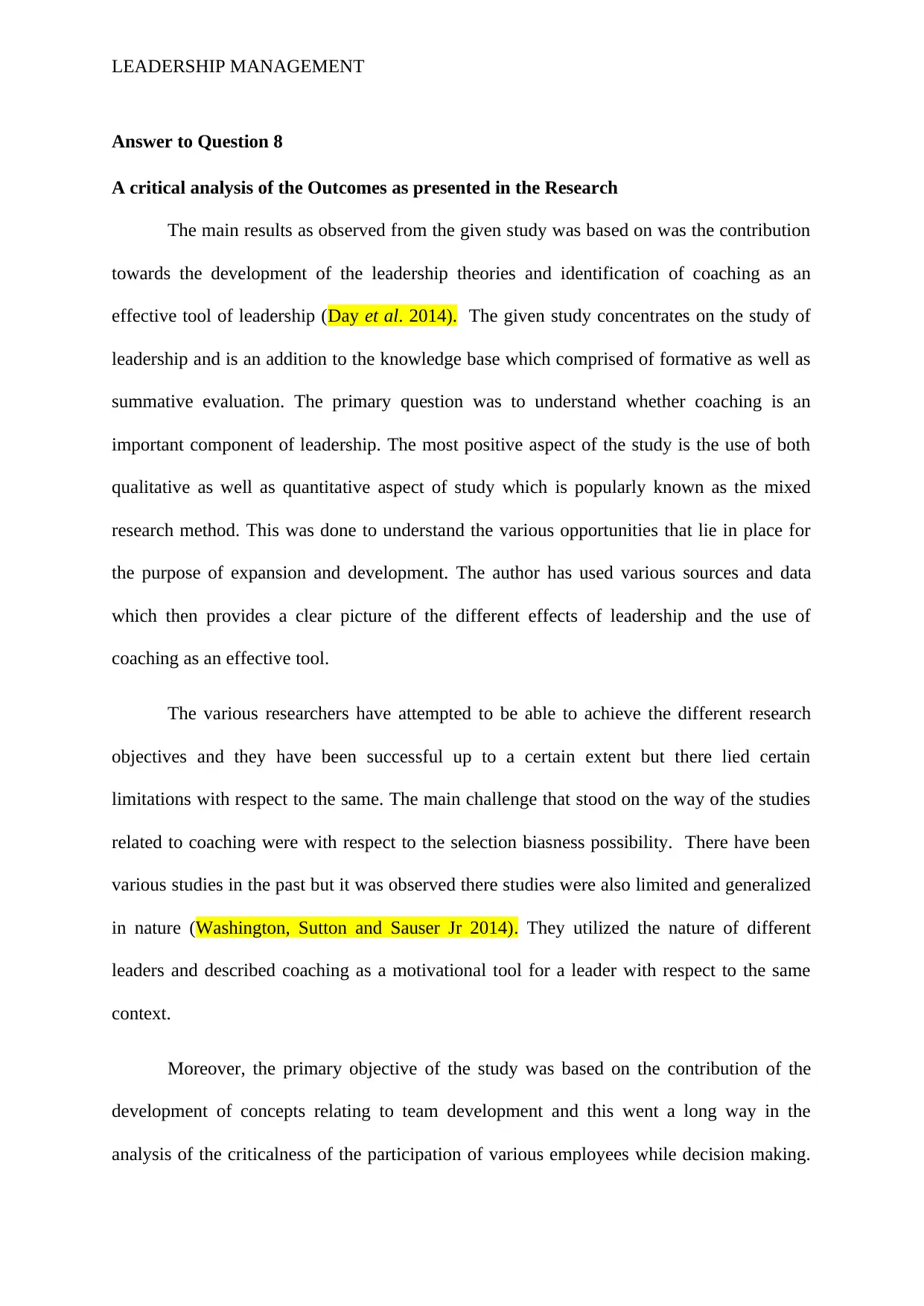
LEADERSHIP MANAGEMENT
Answer to Question 8
A critical analysis of the Outcomes as presented in the Research
The main results as observed from the given study was based on was the contribution
towards the development of the leadership theories and identification of coaching as an
effective tool of leadership (Day et al. 2014). The given study concentrates on the study of
leadership and is an addition to the knowledge base which comprised of formative as well as
summative evaluation. The primary question was to understand whether coaching is an
important component of leadership. The most positive aspect of the study is the use of both
qualitative as well as quantitative aspect of study which is popularly known as the mixed
research method. This was done to understand the various opportunities that lie in place for
the purpose of expansion and development. The author has used various sources and data
which then provides a clear picture of the different effects of leadership and the use of
coaching as an effective tool.
The various researchers have attempted to be able to achieve the different research
objectives and they have been successful up to a certain extent but there lied certain
limitations with respect to the same. The main challenge that stood on the way of the studies
related to coaching were with respect to the selection biasness possibility. There have been
various studies in the past but it was observed there studies were also limited and generalized
in nature (Washington, Sutton and Sauser Jr 2014). They utilized the nature of different
leaders and described coaching as a motivational tool for a leader with respect to the same
context.
Moreover, the primary objective of the study was based on the contribution of the
development of concepts relating to team development and this went a long way in the
analysis of the criticalness of the participation of various employees while decision making.
Answer to Question 8
A critical analysis of the Outcomes as presented in the Research
The main results as observed from the given study was based on was the contribution
towards the development of the leadership theories and identification of coaching as an
effective tool of leadership (Day et al. 2014). The given study concentrates on the study of
leadership and is an addition to the knowledge base which comprised of formative as well as
summative evaluation. The primary question was to understand whether coaching is an
important component of leadership. The most positive aspect of the study is the use of both
qualitative as well as quantitative aspect of study which is popularly known as the mixed
research method. This was done to understand the various opportunities that lie in place for
the purpose of expansion and development. The author has used various sources and data
which then provides a clear picture of the different effects of leadership and the use of
coaching as an effective tool.
The various researchers have attempted to be able to achieve the different research
objectives and they have been successful up to a certain extent but there lied certain
limitations with respect to the same. The main challenge that stood on the way of the studies
related to coaching were with respect to the selection biasness possibility. There have been
various studies in the past but it was observed there studies were also limited and generalized
in nature (Washington, Sutton and Sauser Jr 2014). They utilized the nature of different
leaders and described coaching as a motivational tool for a leader with respect to the same
context.
Moreover, the primary objective of the study was based on the contribution of the
development of concepts relating to team development and this went a long way in the
analysis of the criticalness of the participation of various employees while decision making.
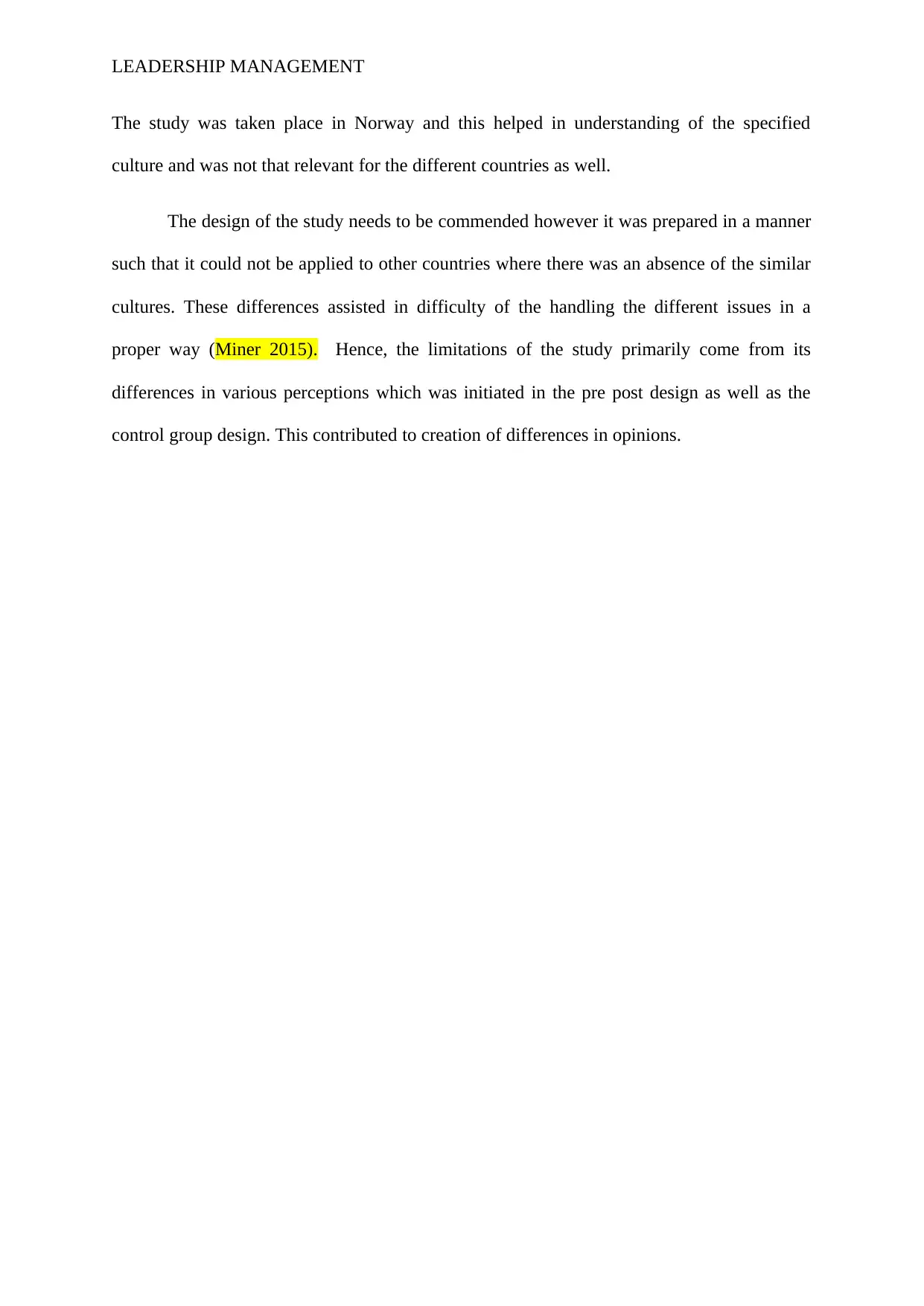
LEADERSHIP MANAGEMENT
The study was taken place in Norway and this helped in understanding of the specified
culture and was not that relevant for the different countries as well.
The design of the study needs to be commended however it was prepared in a manner
such that it could not be applied to other countries where there was an absence of the similar
cultures. These differences assisted in difficulty of the handling the different issues in a
proper way (Miner 2015). Hence, the limitations of the study primarily come from its
differences in various perceptions which was initiated in the pre post design as well as the
control group design. This contributed to creation of differences in opinions.
The study was taken place in Norway and this helped in understanding of the specified
culture and was not that relevant for the different countries as well.
The design of the study needs to be commended however it was prepared in a manner
such that it could not be applied to other countries where there was an absence of the similar
cultures. These differences assisted in difficulty of the handling the different issues in a
proper way (Miner 2015). Hence, the limitations of the study primarily come from its
differences in various perceptions which was initiated in the pre post design as well as the
control group design. This contributed to creation of differences in opinions.
Secure Best Marks with AI Grader
Need help grading? Try our AI Grader for instant feedback on your assignments.
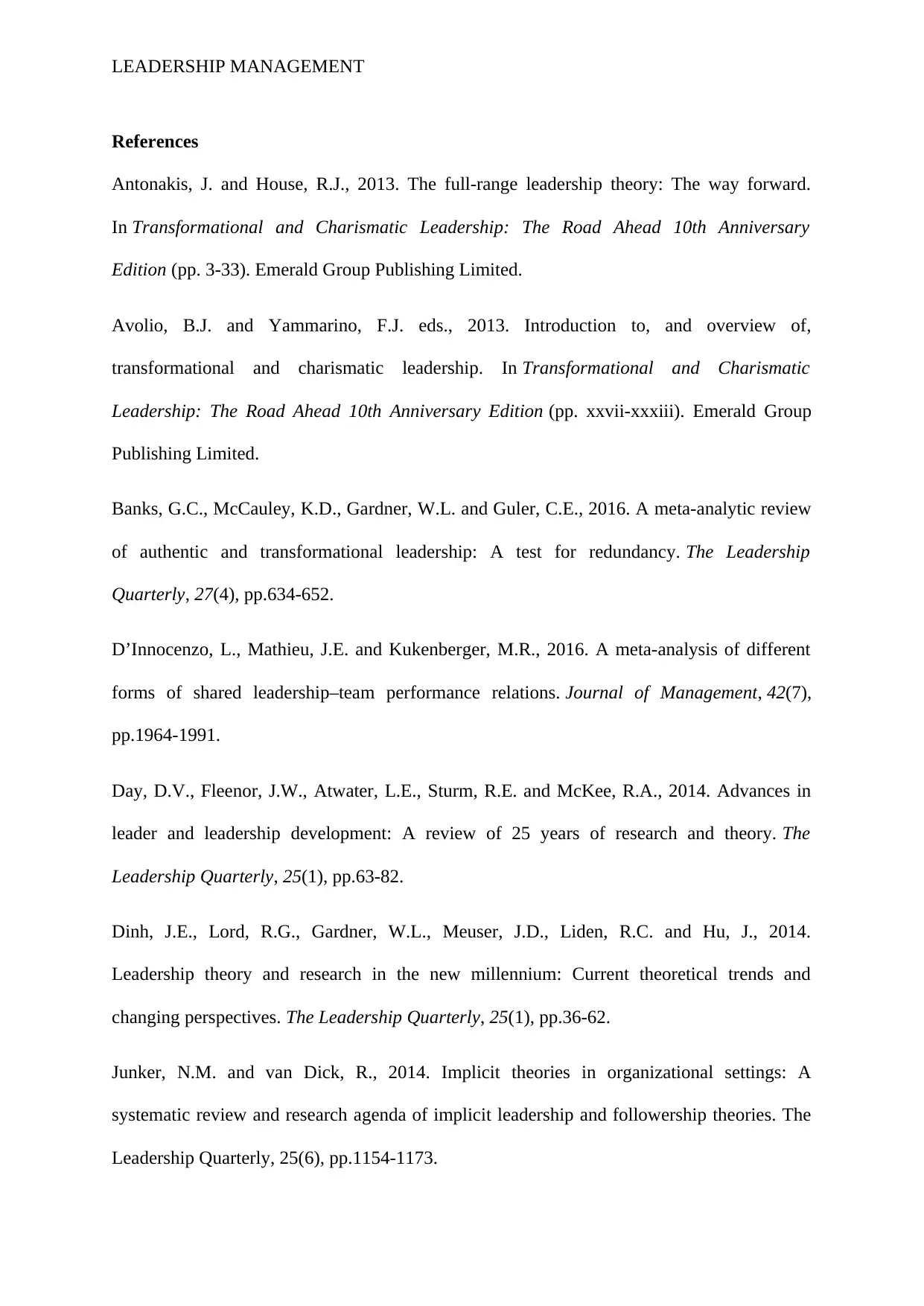
LEADERSHIP MANAGEMENT
References
Antonakis, J. and House, R.J., 2013. The full-range leadership theory: The way forward.
In Transformational and Charismatic Leadership: The Road Ahead 10th Anniversary
Edition (pp. 3-33). Emerald Group Publishing Limited.
Avolio, B.J. and Yammarino, F.J. eds., 2013. Introduction to, and overview of,
transformational and charismatic leadership. In Transformational and Charismatic
Leadership: The Road Ahead 10th Anniversary Edition (pp. xxvii-xxxiii). Emerald Group
Publishing Limited.
Banks, G.C., McCauley, K.D., Gardner, W.L. and Guler, C.E., 2016. A meta-analytic review
of authentic and transformational leadership: A test for redundancy. The Leadership
Quarterly, 27(4), pp.634-652.
D’Innocenzo, L., Mathieu, J.E. and Kukenberger, M.R., 2016. A meta-analysis of different
forms of shared leadership–team performance relations. Journal of Management, 42(7),
pp.1964-1991.
Day, D.V., Fleenor, J.W., Atwater, L.E., Sturm, R.E. and McKee, R.A., 2014. Advances in
leader and leadership development: A review of 25 years of research and theory. The
Leadership Quarterly, 25(1), pp.63-82.
Dinh, J.E., Lord, R.G., Gardner, W.L., Meuser, J.D., Liden, R.C. and Hu, J., 2014.
Leadership theory and research in the new millennium: Current theoretical trends and
changing perspectives. The Leadership Quarterly, 25(1), pp.36-62.
Junker, N.M. and van Dick, R., 2014. Implicit theories in organizational settings: A
systematic review and research agenda of implicit leadership and followership theories. The
Leadership Quarterly, 25(6), pp.1154-1173.
References
Antonakis, J. and House, R.J., 2013. The full-range leadership theory: The way forward.
In Transformational and Charismatic Leadership: The Road Ahead 10th Anniversary
Edition (pp. 3-33). Emerald Group Publishing Limited.
Avolio, B.J. and Yammarino, F.J. eds., 2013. Introduction to, and overview of,
transformational and charismatic leadership. In Transformational and Charismatic
Leadership: The Road Ahead 10th Anniversary Edition (pp. xxvii-xxxiii). Emerald Group
Publishing Limited.
Banks, G.C., McCauley, K.D., Gardner, W.L. and Guler, C.E., 2016. A meta-analytic review
of authentic and transformational leadership: A test for redundancy. The Leadership
Quarterly, 27(4), pp.634-652.
D’Innocenzo, L., Mathieu, J.E. and Kukenberger, M.R., 2016. A meta-analysis of different
forms of shared leadership–team performance relations. Journal of Management, 42(7),
pp.1964-1991.
Day, D.V., Fleenor, J.W., Atwater, L.E., Sturm, R.E. and McKee, R.A., 2014. Advances in
leader and leadership development: A review of 25 years of research and theory. The
Leadership Quarterly, 25(1), pp.63-82.
Dinh, J.E., Lord, R.G., Gardner, W.L., Meuser, J.D., Liden, R.C. and Hu, J., 2014.
Leadership theory and research in the new millennium: Current theoretical trends and
changing perspectives. The Leadership Quarterly, 25(1), pp.36-62.
Junker, N.M. and van Dick, R., 2014. Implicit theories in organizational settings: A
systematic review and research agenda of implicit leadership and followership theories. The
Leadership Quarterly, 25(6), pp.1154-1173.
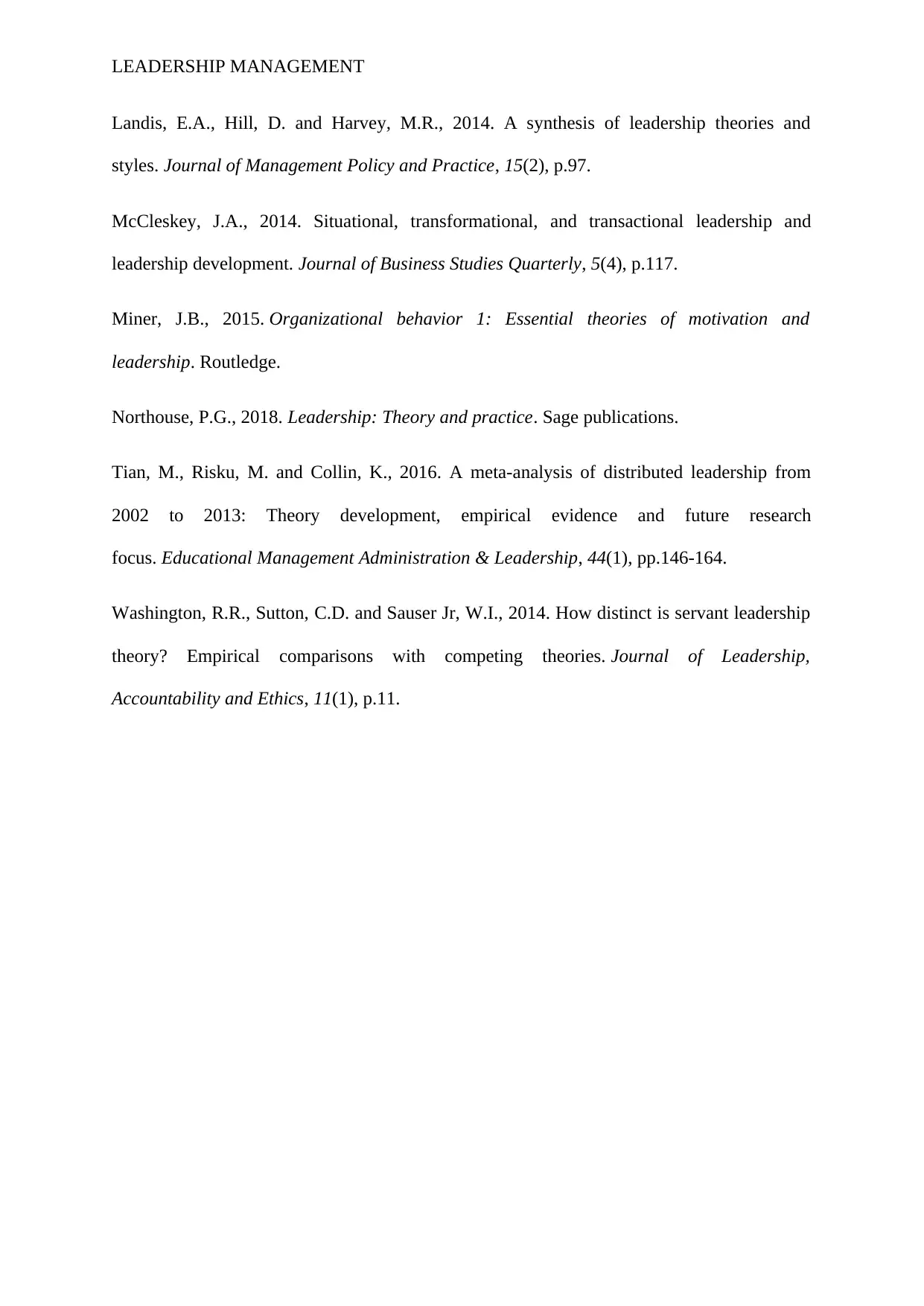
LEADERSHIP MANAGEMENT
Landis, E.A., Hill, D. and Harvey, M.R., 2014. A synthesis of leadership theories and
styles. Journal of Management Policy and Practice, 15(2), p.97.
McCleskey, J.A., 2014. Situational, transformational, and transactional leadership and
leadership development. Journal of Business Studies Quarterly, 5(4), p.117.
Miner, J.B., 2015. Organizational behavior 1: Essential theories of motivation and
leadership. Routledge.
Northouse, P.G., 2018. Leadership: Theory and practice. Sage publications.
Tian, M., Risku, M. and Collin, K., 2016. A meta-analysis of distributed leadership from
2002 to 2013: Theory development, empirical evidence and future research
focus. Educational Management Administration & Leadership, 44(1), pp.146-164.
Washington, R.R., Sutton, C.D. and Sauser Jr, W.I., 2014. How distinct is servant leadership
theory? Empirical comparisons with competing theories. Journal of Leadership,
Accountability and Ethics, 11(1), p.11.
Landis, E.A., Hill, D. and Harvey, M.R., 2014. A synthesis of leadership theories and
styles. Journal of Management Policy and Practice, 15(2), p.97.
McCleskey, J.A., 2014. Situational, transformational, and transactional leadership and
leadership development. Journal of Business Studies Quarterly, 5(4), p.117.
Miner, J.B., 2015. Organizational behavior 1: Essential theories of motivation and
leadership. Routledge.
Northouse, P.G., 2018. Leadership: Theory and practice. Sage publications.
Tian, M., Risku, M. and Collin, K., 2016. A meta-analysis of distributed leadership from
2002 to 2013: Theory development, empirical evidence and future research
focus. Educational Management Administration & Leadership, 44(1), pp.146-164.
Washington, R.R., Sutton, C.D. and Sauser Jr, W.I., 2014. How distinct is servant leadership
theory? Empirical comparisons with competing theories. Journal of Leadership,
Accountability and Ethics, 11(1), p.11.
1 out of 12
Related Documents
Your All-in-One AI-Powered Toolkit for Academic Success.
+13062052269
info@desklib.com
Available 24*7 on WhatsApp / Email
![[object Object]](/_next/static/media/star-bottom.7253800d.svg)
Unlock your academic potential
© 2024 | Zucol Services PVT LTD | All rights reserved.


